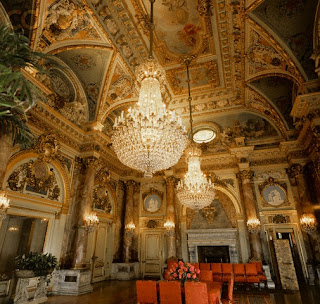The Aina Mahal, Kutch is an 18th-century palace located next to the Prag Mahal in Bhuj, Gujarat. Built by Rao Lakhpatji (1752 - 1761) in 1761 its chief architect was Ram Singh Malam, who was well supported by the local builder community (Mistris of Kutch) in the construction work. His assistant was one Gaidhar Devshi. The ruler Lakhpatji, was a competent administrator, poet and critic, and was as much known for his talents in his exposition of classical music as for his bravery in battle field. As for his master craftsman Ramsingh, he was equally versatile and had the uncanny ability to give shape to his complicated ideas.
 |
| Aina mahal, Bhuj. pinterest.com |
 |
| Aina Mahal, Bhuj. Outlook India |
The water bodies with fountains in this palace form a variety of patterns that make the visitors drop their
 |
| Bhuj and other areas.Gujarat Weather-Forecast.com |
Glass-paintings, mirrors of all sizes every where, the effect was just overwhelming. In the bed chamber, the big bed with gold legs are surrounded by not less than seven outsize mirrors in Baroque-style gilt frames. About 4000 planks and countless pieces of mirror were sourced from Jaipur to make this set. A combination of convex and flat mirrors were used in a subtle manner to give it a 3D effect.
 |
| Aina Mahal, Bhuj. www.hindustantimes.com/ |
 |
| Now in bad shape. Aina mahal, Bhuj. indovacation.net |
When architect Ramsingh, years later came back to Kutch, Rao Lakhpatji gave him a chance to bring out his skills and imagination. The Aina Mahal was now embellished with Venetian-style chandeliers, silver objects, clocks-all made locally under the Ramsingh’s direction. It was a deliberate display of opulence and wealth, an envy of the Jadeja Nobles who refused to be humbled and self-effacing. Aina Mahal is also a museum and here on display are fine local craft like scroll paintings, jewelled swords, ivory inlaid doors and paintings, including European - both portrait and landscaping. Also included are photographs, royal possessions and finest samples of the Kutch embroidery. After the earthquake, part of Aina Mahal was in shamples. The Gujarat Government had a serious plan to repair and restore this beautiful building back to old grandeur.
https://www.indianetzone.com/20/aina_mahal_kutch.html









